Use OSINT to Investigate Nonprofit Corruption
The financial and political misuse of nonprofits is a widespread problem that can be uncovered through open source intelligence investigations.

Financial and political misuse of nonprofits is a widespread problem that can be uncovered through open source investigations. This presents a great opportunity for open source researchers and the following article will explain how to do it.

Many politicians and wealth individuals routinely abuse nonprofits for their own benefit. It is common for politicians and powerful people to own or run nonprofits. Unfortunately, many of these nonprofits exist to benefit their owners. Recall that the U.S. President used his charitable foundation to buy a portrait of himself.
However, National Bureau of Economic Research published an extensive study, “Tax Exempt Lobbying: Corporate Philanthropy as a Tool For Political Influence”, revealing that this is now a common practice. Click here to read. See below for the summation of the study’s findings.

With this in mind, I will explain how to research nonprofits linked to politicians (the same methods work for nonprofits owned by the extremely rich) and show how to make sense of their tax records.
Deep web sources can show connections between people and money that identify where there is corruption.
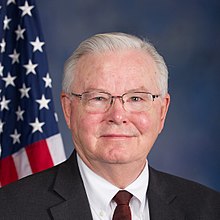
Case Study: Joe Barton Foundation – Congressman Joe Barton
The study’s authors referenced Congressman Joe Barton as someone that used their nonprofit for their own benefits so I chose him and his foundation, the Joe Barton Family Foundation, as a case study that shows classic methods of misuse.
This will show how it is possible for anyone to investigate a nonprofit.
First, to give credit where it is do, it must be made clear that this case study investigation is largely based on following in the footsteps of the April 6th 2009 article by Jerry Seper, titled “EXCLUSIVE: Barton Foundation Not So Charitable“, in the Washington Times.
As noted above, politicians commonly use charities to their own benefit to improve their public image and even to gain financially at times. At first glance it might be difficult to imagine how a charity could end up gaining political support for a candidate. This case study will demonstrate how one politician used his charity in this way.
This study follows the case of Congressman Joe L. Barton during the period he was Chair of the House Energy Committee (that fact will be relevant later) approximately 2004 to 2008 and his creation of private foundation. This events occurred a while ago but I am using resources and methods that are intended for modern day investigations.
Local Press
While he was a sitting member of Congress, Barton repeatedly made public statements about his foundation’s work and its donations to local charities. Usually when someone owns a foundation with their name on it they are using their own money to finance it and its donations.
Barton founded a foundation in 2005 called the Joe Barton Family Foundation. The reported purpose of this foundation was to support charities in Barton’s district.
A quick google search would show the kinds of PR that the foundation generated for Barton. Here are some examples.
Press reported (click here to read more) that the Barton Family Foundation pledged to raise up to $400,000 to help build a Boys and Girls Club and to raise $500,000 to help build a regional kitchen and offices for the Meals-on-Wheels program. Both projects were in Barton’s district.
For the local Boys and Girls Club (BGC), publicized his role in supporting the project at public events. According to a statement by AT&T, Barton accepted a $50,000 check on behalf the BGC at a public event organized by donor, AT&T. Barton made public statements about the project and an AT&T spokesperson publicly thanked Barton for making the project possible.
Barton also attended the groundbreaking ceremony and gave a public speech. A local paper reported that Barton was introduced at the event as the person “making this event possible” and then “Barton took the stage and said the dream had become a reality”.
Barton’s foundation blatantly gained attention in the local press and praise for him personally. Research by the Washington Times after the fact showed at the time the local Ennis Daily News reported Barton was “the special guest at a VIP Reception” because he had made the first donation to the Meals-on-Wheels program.

Texas Monthly magazine reported in 2005 that a local townhall meeting “burst into applause” for Barton when he announced his foundation’s pledge for the Boys and Girls Club.
The Washington Times reported in a 2009 article: “The Barton foundation was among several groups honored for their philanthropy during Nov. 6 ceremonies in Fort Worth sponsored by the Association of Fundraising Professionals. The foundation was flagged for its pledge of $500,000 for the Meals-on-Wheels program.”
Starting the Investigation
In order to avoid the kind of obvious information about the nonprofit that you find in a Google search and possibly find something from behind the scenes, I start by looking up the registration for the Barton Foundation.
OpenCorporates.com, a website that allows you to search many government registries at once, is usually a good place to start. With nonprofits your results in Open Corporates may vary depending on the state. A search for the foundation’s name finds registration information for it from a Texas registry.
The registration information in Open Corporates includes an incorporation date (April 5th 2005), an address (3100 sprocket drive, arlington, texas), a few names of “directors”, and a link to the source of the information (The Texas Comptroller of Public Accounts) with a url (https://mycpa.cpa.state.tx.us/coa/).

Sometimes the original source of the information has a bit more detail so I look up the foundation at the url provided and find the registration itself. One notable addition is the Registered Agent Name, one Gary Martin.
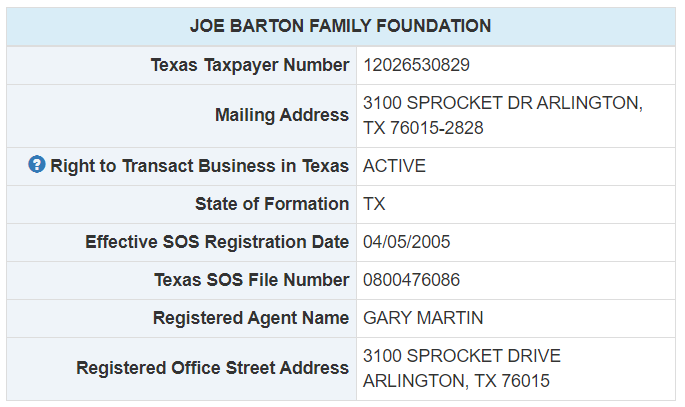
Finally, one easy step I learned from the book, A Deal With the Devil by Blake Ellis and Melanie Hicken, is to check if the place has a real physical presence. You can do this by checking the address in Google Maps or Street View. A more legit operation will often have some form of office with their name at the address.
But when we search 3100 Sprocket Dr what we find is not an office for the Barton Foundation, but a company called Martin Sprocket & Gear. If we check with Street View there is no sight of any office with the words “Barton” or “Foundation”. We only see the business’ headquarters building.

If the name “Martin” sounds familiar, that is because we just saw that the Registered Agent Name for the Barton Foundation is someone named Gary Martin. A search in Open Corporates shows that this person, Gary Martin, also owns the company that is located at the same address where he appears to have registered the Barton Foundation.
What is a Registered Agent? An entity like a company or nonprofit can legally designate a registered agent to receive correspondence on its behalf, like a legal summons. If the agent is not affiliated with the company, it will usually be a lawyer that provides this service for a fee.
In practice, the agent can act as a barrier to the entity by hiding the entity’s owner, address, phone number, etc. On paper, the entity can often list the registered agent’s contact information instead of its own.
Bad actors can abuse the role of a registered agent to hide things about themselves. For example shell companies (a topic for another day) use agents to hide that the company does not actually exist.
Martin and Barton Relationship
Martin apparently was not the foundation’s owner, employee, or lawyer. More likely he was just someone tied to Barton.
Research into Martin showed he was a major political donor. A search in OpenSecrets.com identified that Martin’s company, Martin Sprockett & Gear, donated over $100,000 to Barton’s campaigns and ranks overall as Barton’s 10th biggest donor.
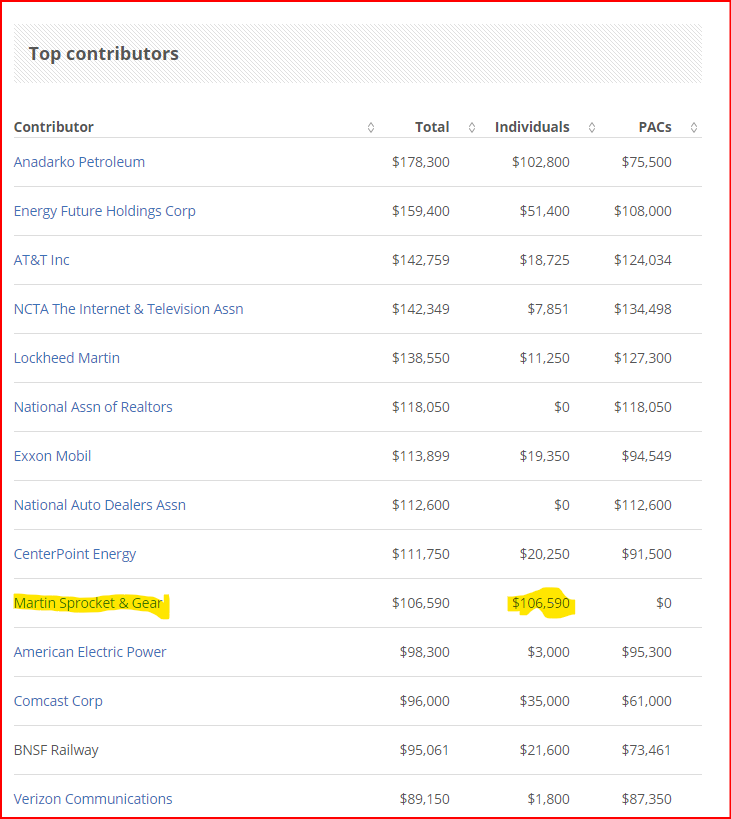
This suggests that maybe Barton just asked a friend/associate to register the foundation at his company’s address. That would be easier than actually creating a real headquarters. There is certainly nothing wrong with running a shoestring operation, but as you will soon see, the foundation was NOT being run on the cheap.
Also, there will be mounting evidence that maybe Barton just created the foundation for the sake of having a foundation, which might explain why he put less effort into actually establishing it. But that is just speculation.
This information is not evidence of wrongdoing but it does show what is generally referred to as a “pattern of suspicious behavior”. When proof is not available, it is still useful to identify suspicious behavior. The tax filings will prove to be a more fruitful source of information.
Tax Filings

We know what was going on publicly with the foundation, but we can look at the tax records to see what was actually happening behind the scenes. There have been many cases of politicians using their nonprofits to avoid taxes, improve their public image, and/or even enrich their friends and family.
Nonprofit organizations in the U.S. must file their taxes in a Form 990 every year and the IRS makes those records available to the public. But they are very hard to read if you do not understand what you are looking at.

There is an IRS public database for looking up the tax records of nonprofits but if you look up the records for the Barton foundation, you see the records only go back to 2016. However, Propublica maintains a similar database of filings obtained from the IRS but in a more user-friendly format and with records going back much further.
We can search for the nonprofit by name at the Propublica site and we get a list of the foundation’s records going back to its establishment in 2005. Let’s look at the first tax filing.
At fist glance, the tax filing is a daunting and confusing mess of numbers and tax phrases that make no sense. So I will identify the important parts and explain what to look for in them.
Questions to Ask

Now that we’ve found the records, we want to consider a few questions to answer. Did the politician fund the nonprofit or are they spending other people’s money?
Did the nonprofit’s actions reflect public statements by the politician?
Who benefited financially from the nonprofit?
To elaborate on the last question, did anyone close to the politician benefit (because that would suggest a conflict of interest)?
Unfortunately, the public tax records for nonprofits come in a poor quality PDF that lacks optical character recognition (which would let us do a word search). Propublica is converting more recent records, but that does not help us here. The quality of the files will not be a problem if you know where to look.
Whose money is it?
The first question we will look into is whether Barton is funding his foundation. It is generally implied when someone creates their own foundation in their name and announces that they will be donating money to a cause, that the person is donating their own money. In most cases this is true.
Let’s find out if the Congressman was using his own money and if not, how much money was coming into the organization. We will start with the foundation’s first filing from 2005, the records are located here at ProPublica.
The first place to look in the tax record is on page 1 where there is a summation of the nonprofit’s expenses in the section named “Part I: Revenues, Expenses, and Changes in Net Assets or Fund Balances”.
In this section, we see in item 1 that the Barton Foundation gained $235,000 that year.
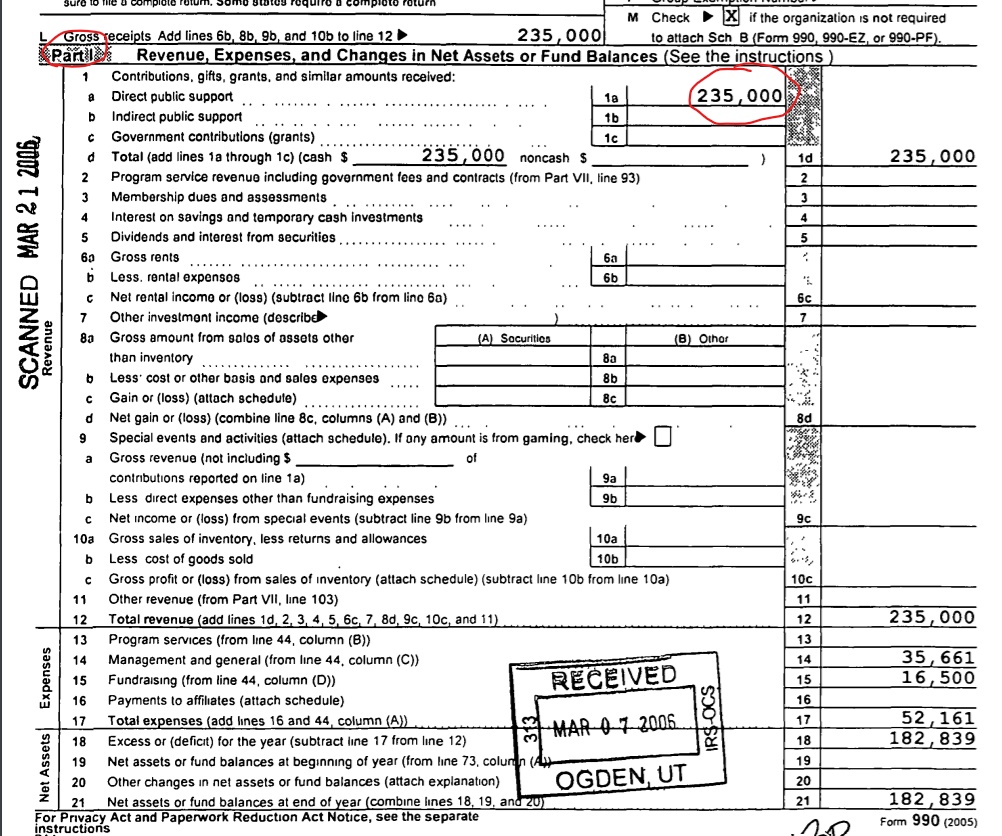
Before proceeding, let’s look for a section called Schedule B to find out if this money is from the politician. We are looking for Schedule B because if any single contributor donated more that $5,000 then they are supposed to be be identified in this section. If Barton is funding this operation, he would need to list himself in this section, especially for the sake of the major tax write-off.
However, we find that this record does not have a Schedule B included. Generally speaking, this implies that there was no one that gave more than $5,000, but does not quite prove it. This is common because many nonprofits do not want to identify their contributors.
For our purpose, this is useful because it means the nonprofit’s money did not come from the Barton himself, it is other people’s money.
It is still possible to find the donors by looking elsewhere, more on that later.
Where did they spend the money?
Let’s return to page 1, part 1. Here, item 17 shows that the Barton Foundation spent about $52,000 in 2005. For more information about those expenses we can look at items 13-16. We see here that no money was spent on “Program services” (i.e. charitable activities). However, $35,000 was spent on the vaguely named “Management and general” (more on this in a bit)), and $16,000 on “Fundraising.”
Spending money on fundraising is to be expected and it is also reasonable that the organization did not perform any services in its first year of existing. But the management expenses are more curious.
Senior Officers and Employees
If we scroll down to “Part V-A” we will see the organization’s leadership. There are several names here that we could investigate but one in particular jumps out. The foundation paid Thomas L Driskell $32,000 for reporteredly working 40 hours per wee
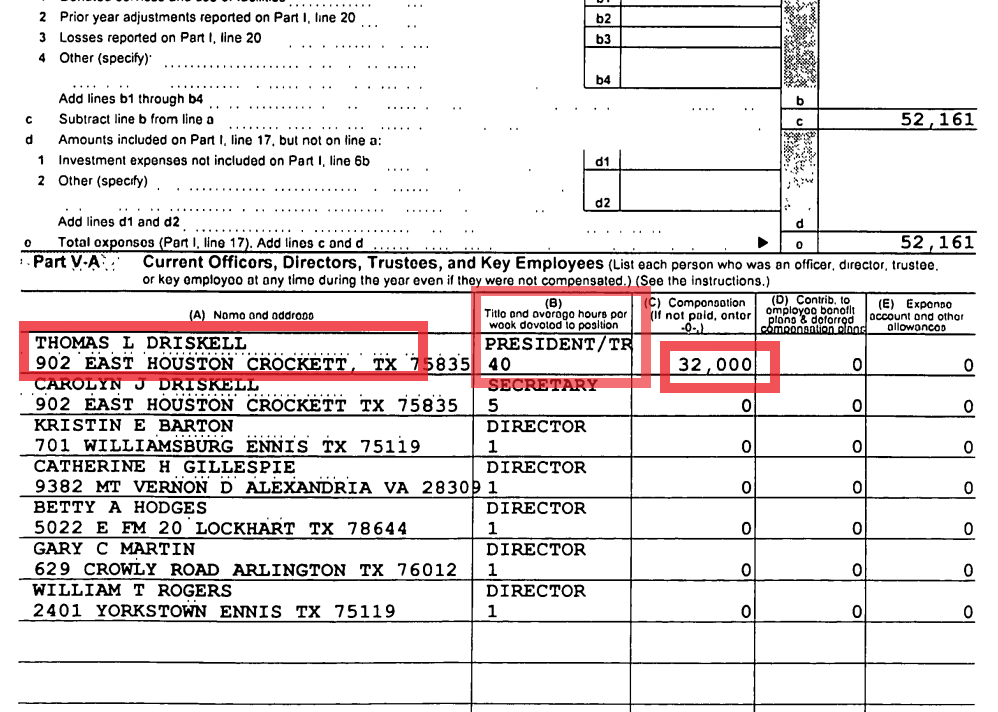
So at the end of 2005, during the organization’s admittedly short period of existence it has not conducted any charitable services but it has paid mr. Driskell 32,000.
According to the tax record, Driskell was working 40 hours per week at the foundation, even though he already had a job running an accounting firm, based on the firm’s registration.

So now we might ask, who is Thomas Driskell? Is he qualified for this job” What is his relationship with Barton?
We are interested in Driskell’s qualifications and his relationship with Barton because we want to determine if there is a conflict of interest here. With regard to running a nonprofit, a conflict of interest is generally defined as a scenario where the person owning the organization chooses a friend or close associate for a position despite the fact that they are not qualified. Their friendship conflicts with their obligation to choose qualified employees. This is not illegal as long as the owner did not choose their friend over a separate applicant. However, there is a practice of nonprofit owners basically giving money to their friends by giving them a job where they do little or nothing but get paid via contributions to the program. Is that what is happening here?
Who is Driskell? We begin by searching for possible job experience in the field. A search in Propublica’s database and Open Corporates (which is a good but admittedly not an exhaustive way to search for nonprofit experience) do not show any results that indicate that Driskell had any experience managing a nonprofit as of 2005.
A google search shows that he is an accountant with his own accounting firm though, so he has experience handling money. But the word “nonprofit” does not appear in the section of the website for services offered. Further, the word “nonprofit” appears nowhere on the company website (cpadriskell.com) which could suggest that the company does not have experience or offer services for nonprofits.
Driskell and Barton Relationship
Contributions: Neither individual has much of a social media presence, so we will look at alternative means of investigation. To begin researching Driskell and Barton’s relationship, lets look into his relationship with Barton. We search the FEC database for political contributions here, and discover that Driskell and several other people with the same last name (presumed family members) have been donating to Barton’s political campaigns since the 1990s.

Statements: Another good database to search for anything related to a member of Congress is Govinfo.gov. At this site you can look in a variety of government records databases and many relate to Congressional documents. This is kind of like a google search of documents related to congress. What is most important for us is that this database includes transcripts from Congress so we can look for any statements made by Barton about Driskell from the House.
To do this we can search here for any document that has the names of Barton and Driskell together. Our search has one result, which is the transcription of a ceremony from 2008.
Both men attended the ceremony and in the process of their statements they revealed that they were longtime friends, previously worked together in politics, and were still close. The following are the key highlights:
- Barton’s statement that “Tommy” is “the guy who got me into politics.”
- Driskell and Barton were from Crockett, Texas, where Driskell used to be the mayor.
- Barton used to be Driskell’s campaign manager.
- In 2008 the men were still good friends, evidenced by the fact that Driskell and his wife interrupted a vacation in South America to attend a ceremony honoring Barton.
Conclusion on Driskell
Now we know that Driskell definitely had close personal ties with Barton but we arguably did not find reasonable qualifications for his role as the president in the nonprofit.
We could make a subjective argument that Barton faced a conflict of interest between his interest in hiring the best candidate to run the nonprofit as opposed to his interest in supporting a friend and donor. However, this is actually legally fine.
What is legal? We do not know for certain how the hiring process occurred. From a legal perspective, according to an article about nepotism from Boardeffect.com, someone like Barton could decide to hire a friend. But legally, he would be in trouble if he chose to hire his friend instead of a more qualified second candidate for the job.
Website
This next part is outside the bounds of this investigation because of the date when this information came to light. However it is an interesting side note that is worth mentioning only to the extent that it adds to the impression of suspicious behavior in retrospect (our investigation could have continued without this information, feel free to skip to the next section).
During the google searching for this foundation there appeared to be no website. Later, in the 2008 tax returns we see that the organization did spend money on a website.

It is the opinion of this post’s author that it speaks to the apparently lax nature of the Barton Foundation that it took 3 years for the foundation to get around to setting up a website. I believe that it is ultimately a tiny bit more evidence suggesting that the foundation was created for the sake of making public statements about the foundation, and less so for the purpose of doing real charity.
If we google the name of the foundation and the word “website” we see a reference on Guidestar.org (a site that is similar to the propublica nonprofit searcher) to a former website’s url. The website (joebartonfamilyfoundation.org) is no longer active.
We can try to find more information on the website and its history with a tool called Carbon Dating the Web. A search for the foundation’s website in this tool shows some results. The tool estimates that the website was created in 2009 based on the earliest references to the website’s existence.

The results also show where we can find archived version of the website on archive.org and archive.is, see below:

The website gives us some information about what the foundation was actually doing. We see that in 2009 the website shows that the foundation had contributed to two projects (the aforementioned pledges to the Boys and Girls Club and Meals on Wheels).
Looking at the website over time does not show a lot of activity in the foundation.
This website still only had the same two projects to its name as of September 2012. To be fair, the next archive for the website in June 2013
showed that a 3rd project had finally been added to the list. But 6 years later (shortly before the website was shut down), the last archive of the website still showed that there were no new projects.
Moving Forward with the Taxes
Now that we’ve establishing the framework of what information is relevant and where to find it, let’s begin skimming through the next few tax returns to see where the money happened behind the headlines.
In 2006 the foundation, per its filings, the unnamed contributors gave the foundation another $195,000.

The foundation finally made a donation and gave $90,000 to the the local chapter of the Boys & Girls Club.
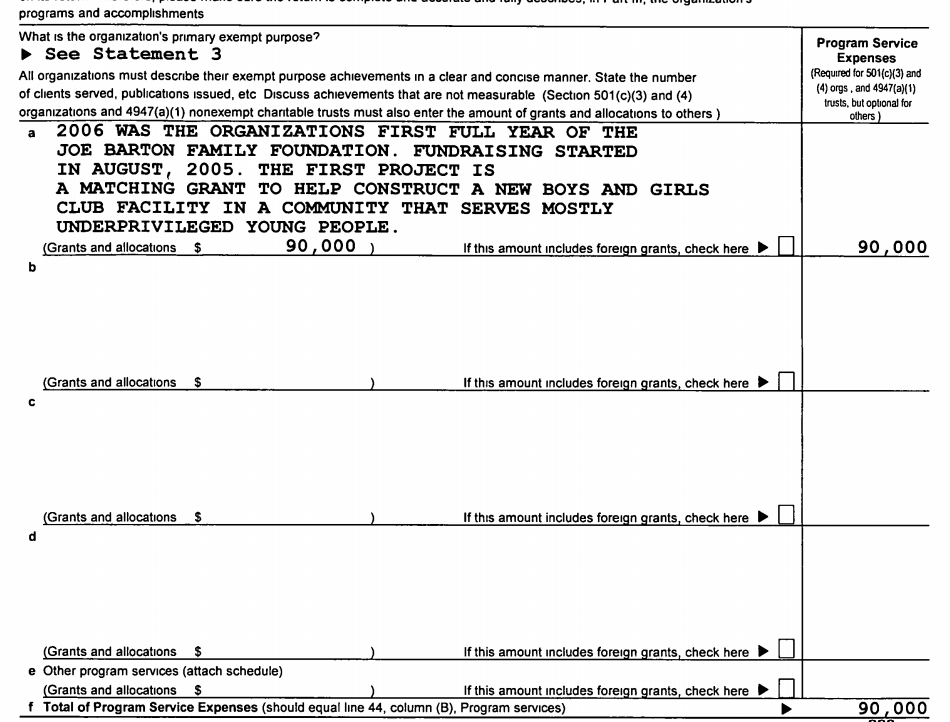
While $90,000 is definitely a significant amount of money, it is important to contrast it with Barton’s public statements. First, recall that in the local press referenced above Barton had initially announced a pledge to raise up to $400,000.
Despite that fact that the foundation’s tax records for 2006 clearly state that it only donated $90,000, the foundation actually claimed that it raised $375,000, according to an article published September 23rd 2006 in the local newspaper the Corsicana Daily Sun.
A Lot of Expenses, Little Output
Also of interest, the foundation continues to have abnormally high expenses for an organization that does little beyond receive money and pay out one check. The foundation spent over $60,000 on contact labor and consulting fees. But it is not clear what those services actually did.

This shows a consistent pattern of an organization that spends a lot of money on itself with high expenses, paid by donors’ money, but does very little work. The expenses are always vaguely described as things like “consulting”. In 2007 we see that the foundation did not receive or donate any money, but it managed to spend over $3,000 on accounting and phone bills.

Let’s look at the money from the aggregate. Up through 2007 we see that over the course of two and a half years, the foundation had received $430,000.

However, during that time the foundation only gave out one donation of $90,000 while at the same time the nonprofit paid itself over $120,000 in expenses.
Another Paycheck
The 2008 filings showed that Barton hired a new president who was paid $48,000. If you look at the new president’s name, it is hard to deny in this case that Barton has a close personal connection to this individual. Amy Barton, the new president, was Joe Barton’s daughter-in-law.

Second Donation
In 2008 the foundation finally made a second donation, $55,000 to the local Meals on Wheels.
The Statement of Program Services is very interesting.

First, we see that the foundation acknowledges that its role only involves giving financial support to other organizations. This confirms that its role in something like building a new Boys & Girls Club does not involved the actual building, just paying a check. This is relevant because its supports the idea that it is very weird for the foundation to have such high expenses when it is, in theory, not actually doing much work.
Second, we see another stark comparison between expenses and payouts. Expenses that year are listed at $69,818, while its grant was only $55,000. a
Third, note another disparity between actions and public statements. The foundation pledged to raid up to $500,000 dollars, not $55,000.
Finally, and most importantly, we learn how the foundation explains the aforementioned disparity. The organization argues that while it pledged to raise up to $500,000, it believes that it can claim credit for donations from OTHER donors’ who gave their money directly to Meals on Wheels. This allows the foundation to publicly pledge very large dollar amounts while actually donating much smaller amounts. This is, in the view of this post’s author, as ridiculous as it sounds. We will see in the conclusion that many others shared this viewe.
Investigation’s Conclusion
At this point, we have obtained a litany of information proving that Congressman Joe Barton grossly misused the Joe Barton Family Foundation for his own benefit.
There is more to say on this topic, there are two important notes to be made.
First, this nonprofit’s activities are not unusual. This example is very standard, which means that you can use the same research methods I’ve described and you can look for the same kinds of information in other nonprofits.
Second, this information eventually formed the basis of a major investigative news scandal and it is important, and hopefully motivating, to note that anyone could find this information in the open sources referenced above.
While this concludes the investigation, there is an interesting epilogue to the story.
Exposure
The information above was publicly exposed on April 6th 2009 when an article by Jerry Seper, titled “EXCLUSIVE: Barton Foundation Not So Charitable“, was published in the Washington Times.
by reporting from the Washington Times in 2009.
Amy Barton, pressed for an explanation of the $375,000 claim, said resorted to a similar explanation that was provided in the tax filings for the Meals on Wheels project. that
Per the Washington Times, Amy Barton said the following:

Amy Barton also refused to name the donors,

We later learned in an explanation of the scandal by Publicintegrity.org about the reason why Barton insisted on claiming credit for donations made by donors’ directly to the charities (recall that he publicly accepted a check from a donor on behalf of the Boys and Girls Club), instead of asking the donors to give the money to the Barton Foundation.
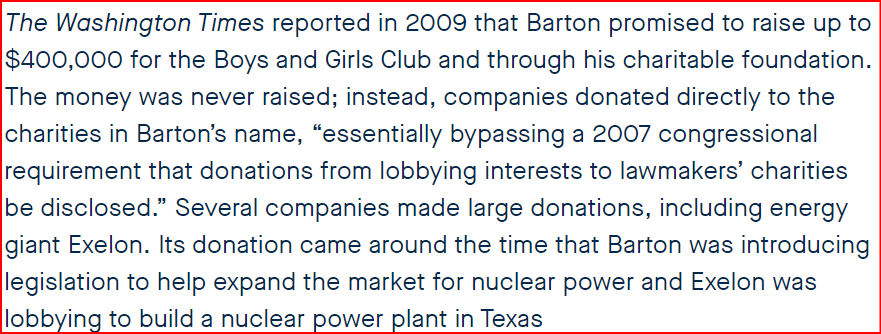
Where Are They Now?
After the news scandal the Barton Foundation was investigated by the Office of Congressional Ethics but no charges were filed. Ultimately, these revelations were not enough to bring an end to Barton’s political career. Barton managed to get reelect again and then again and he was even honored in congress with a portrait ceremony. But that is not the conclusion of Joe Barton’s political story.
Barton remained in office until his career was ultimately ended by the Me Too movement. Barton stepped down from office in 2018 after a scandal involving sexually harassing a constituent, revelations of cheating on wife, Barton sending sexually explicit texts and nude photos of himself that were published in the press. If you are interested in the salacious details, see vox reporting on the matter.
Barton’s Foundation more or less faded out, mostly spending on its own expenses. The last tax filing available from propublica, from 2017, showed the foundation gained $600 but spent over $4,000.

After his somewhat undignified departure politics, Barton still had his longtime friend Gary Martin who hosted a sort of goodbye ceremony in his own home in 2018 “in honor and appreciation of Congressman Joe Barton”.
After the revelations of infidelity, Barton’s wife divorced him.
Barton did not seek reelection in 2018.
What can you do?
It is not difficult to find similar revelations. The study mentioned above from the NBER provides a simple formula for finding where to look.
The researchers revealed that much of the money for these nonprofits originated with major corporations that were also lobbying those same politicians’ whose nonprofits the corporations were also supporting.
The researchers started by looking at big companies in the Fortune 500 and the S&P 500 and then looked at their foundations. Thankfully, the foundations often had the same names as the companies so they are easy to find.
Try a quick search for any of those companies in Propublica’s nonprofit explorer.
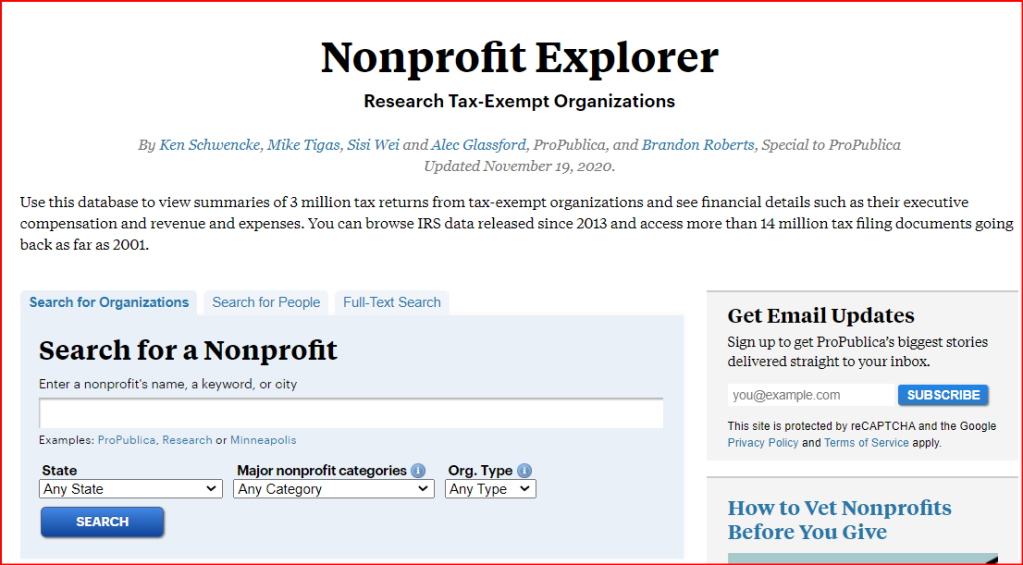
A search for the company Exelon in the propublica searcher found the Exelon Foundation. The foundation’s 2018 tax records show its list of grant recipients.

You do NOT need to look at each of these recipients because the next step is to look at lobbying records. The following is my recommendations of what to do and is based on the descriptions from the study.
You can look into lobbying records by going to OpenSecrets which does a good job of maintaining the federal lobbying disclosure records here:
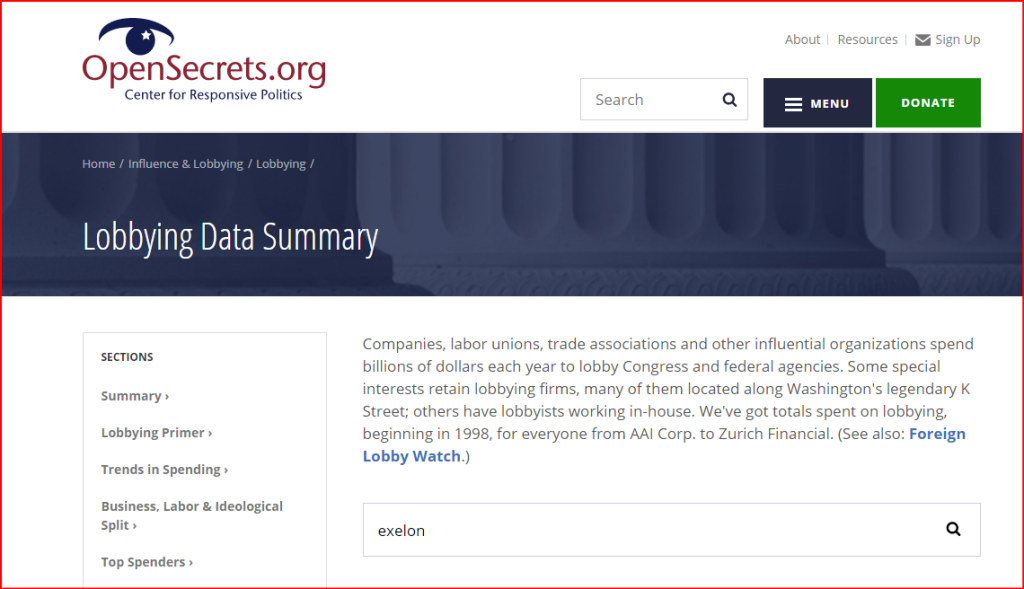
I typed in Exelon and a dropdown menu gave me the option to see the lobbying profile of Exelon Corp. That is this page below. You can see that there is a “Bills” tab that will show you the legislative bills that the company is lobbying. See where it says “Bill Number” at the bottom and click on any bill number.
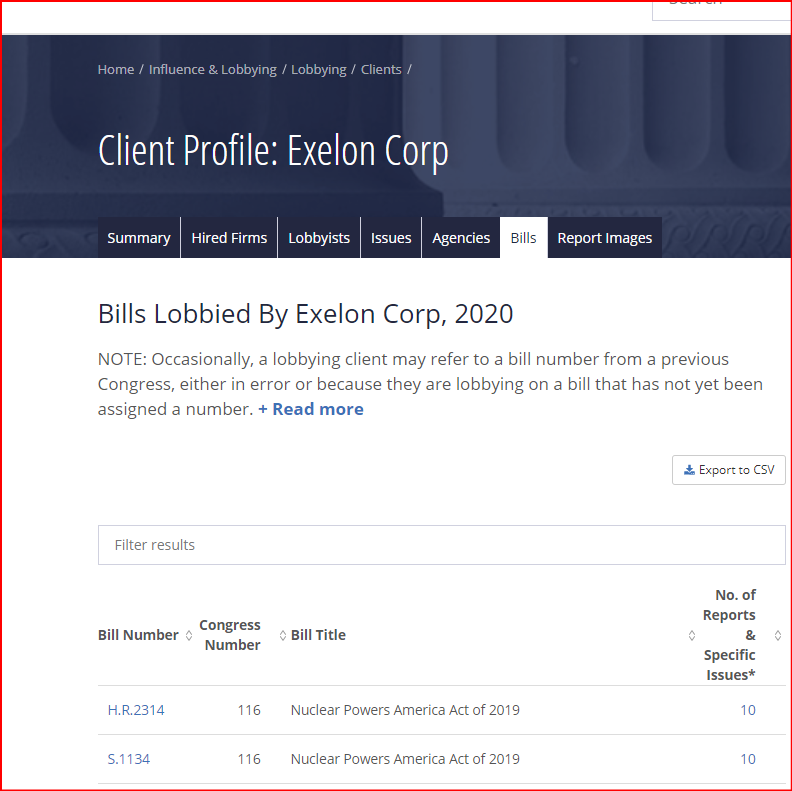
That brings you to this page where there is a tab to click on that says “Sponsors.” You can see the beginning of the list in the picture below.

Click on one of the names and you will see a page like this below. Notice that there is a drop down menu in the middle that lets you look at the different information for this individual for each cycle. You may want to come back to that later to view data from different years.
But for now, click on the tab on the right that says “Other Data”.

Then scroll down and see there at the bottom where it says “View the Full Financial Disclosure Report”. Click on it and while you are at it
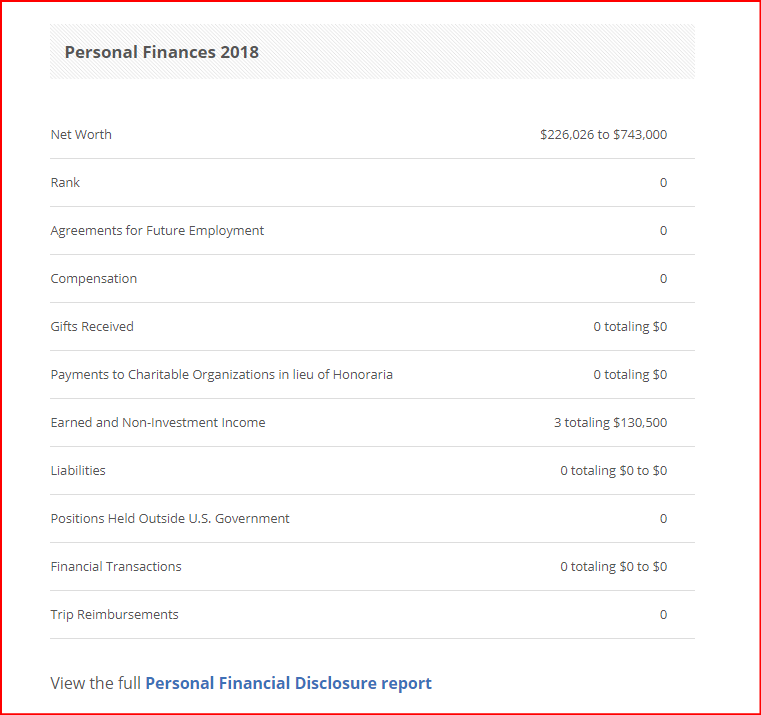
Click on the tab that says “Other Data”, this is usually where they report if they own or sit on the board of a nonprofit. You can also click on the tab that says “Reports” to see the actual pdf file of the disclosure reports. There is thankfully a drop down menu right here so you can look at disclosures from different years.

The nonprofits you see here are the best place to start looking. Even if the politician doesn’t make money from the nonprofit you should look into it.
Also, keep in mind that the researchers of the study mentioned that many of the politicians did not mention in their disclosures their connections to nonprofits. In those cases it took a bit of work and googling to find the nonprofits linked to the politicians.
However, many of these nonprofits actually made an effort to showcase their connections to that politician on their websites or in press so a quick google search might be all you need.
With that said, good luck! (but you won’t need it).
Learn More About The Images We Choose
Today we celebrate the work of noted parapsychologists Dr. Ventman, Dr. Stantz, and Dr. Spegler in the field of ectoplasmic physics and for their invention of the Proton pack. Proton Packs are special because they are the only piece of technology in the world that has the ability to strip electrons away from protons. It has a hand-held wand known as a "neutrona Wand" (also called a particle thrower) connected to a backpack-sized particle accelerator. The Proton Pack, also referred to as a charged particle accelerator, functions by using a miniature cyclotron to concentrate protons by channeling though a "positron collider" and then to the neutrona wand, emitting way-fire positronic ionized stream of proton energy that polarizes with the negatively charged ectoplasmic entities which held them in the stream while active.


